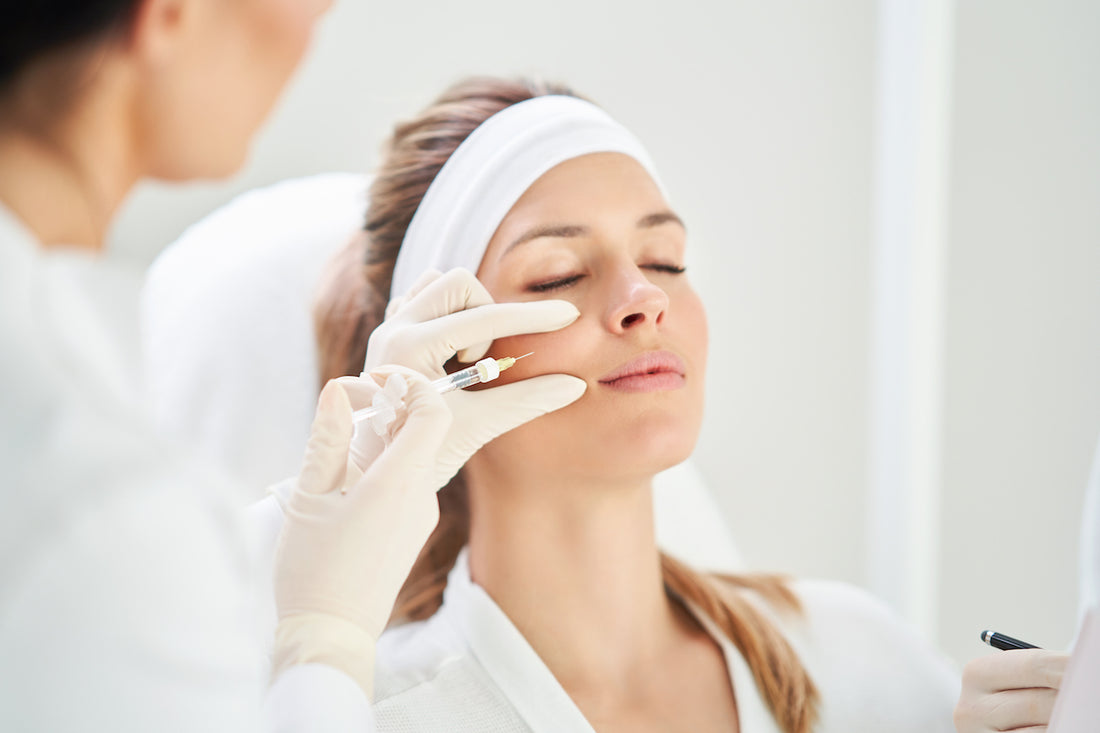Myths and Facts about Botox, Botulinum Toxin Type A and how to use it Safely!
Before we start, let’s just clarify …
BOTOX® is the tradename of one of a range of botulinum toxin A products from Allergan, so to be factual when we are talking about the drug used to inject to aid visual rejuvenation, we are giving facts about botulinum toxin A. Commercially, botulinum toxin A is marketed under the name Botox but there are many other manufacturers of botulinum toxin A: Azzulure, Dysport, Bocouture
What is “botox”?
Botulinum toxin A is a drug made from a neurotoxin produced by the bacterium Clostridium botulinum. It blocks signals from the nerves to the muscles.
How does it work?
A muscle is injected with a tiny amount of botulinum toxin A. The muscle can no longer contract, which causes any wrinkles to relax and soften. It is most often used on forehead lines, crow’s feet and frown lines.
Is it only used in the cosmetic industry?
No, it’s used for a number of medical conditions, including chronic migraine, crossed eyes, excessive sweating (hyperhidrosis), teeth grinding/jaw clenching as well as many body movement disorders.
Is it safe?
“botox” is safe in the right hands if delivered by an experienced practitioner. Studies show very few side effects from “botox”.
Where can “botox” be used on the face?
Forehead, crow’s feet, frown lines, bunny lines, jaw, neck platysmal lines, chin, smile lift.
Can anybody inject “botox”?
Only trained doctors, nurse prescribers and dentists should provide non-surgical cosmetic treatments such as ”botox” says new legislation – produced following a clamp down on the industry.
Currently people such as beauticians with no medical training are administering anti-wrinkle injections, even though it is a potent neurotoxin and they are not a prescriber.
So can any nurse administer “botox”?
Not all nurses are prescribers! Using botox safely you are best advised to work with a doctor, dentist or nurse prescriber for treatment. Botox is a prescriptive drug so if you go to a nurse who cannot prescribe directly, you should be seen by the prescriber on a regular basis too!
Why is “botox” charged at different prices in my area?
There could be a number of reasons for this:
- As with many products, different brands charge different prices. Some brands have more clinical evidence of their product hence may charge more.
BOTOX® by Allergan has a higher content of botulinum toxin A in its product than any other brand and is more expensive as a product to buy, therefore the cost is passed to the patient.
- Some practitioners charge more due to market demands – globally there is a great differential in the price of “botox”.
- Botox comes as a dried powder that must be kept refrigerated. The vial contains either 50 or 100 units. It is reconstituted in normal saline prior to your treatment. There is no set volume of saline that is used. It is up to the individual provider. Different clinics use different dilutions, all of which are potentially valid. There are pros and cons for using different dilutions, but the key is really how many UNITS are being injected into an area, not how many cc’s or vials. Potentially, you could be charged for a vial which has been diluted with less units of “botox”? Beware of unscrupulous practitioners where you are getting less value for your money!
Why do some treatments last for 3 months and others up to 6 months?
- There are subtle differences in the chemical formulations of the main brands of botulinum toxin available in the UK. If your product has less botulinum toxin A in dilution it won’t last as long.
- Some individuals’ muscles are stronger than others so more product may be required more often.
- Unfortunately, you need to beware of some practitioners who insist that you return to them for treatment after 3 months. They may be encouraging you to visit more often for their own benefit!
Do all wrinkles respond to “botox”?
Wrinkles caused by sun damage and gravity will not respond to ”botox”.
What should I ask the practitioner if it is the first time I am visiting for a “botox” treatment?
Q. Is the person a doctor, dentist with experience or nurse prescriber?
If they are, then great! If they’re simply a nurse with experience then you may wish to walk away!
Q. What product is being used?
You can then check the internet if you require more research prior to treatment to validate the practitioner’s information
Q. How often would you need to visit?
You should always be offered a 2 week review following treatment and beware if they insist on a strict 3 months visit period (not everybody needs that)!
Q. Ask for a price for your required treatment.
Sometimes this is given per area, or per unit. Typically, 1 area is around £160-200, 2 areas £230-270 & 3 areas £280-320. If it is significantly less, you may want to question the quality of product, the units being received, and the lasting effect of your treatment!
Can any doctor, dentist or nurse prescriber administer aesthetic treatments?
In theory yes, as they understand the anatomy and nature of the drugs. However, for best results it is advised to work with an aesthetic clinician who has the training, experience and skill to deliver great results.
There is an ‘art’ in skill & experience to using any injectable product to best effect!
